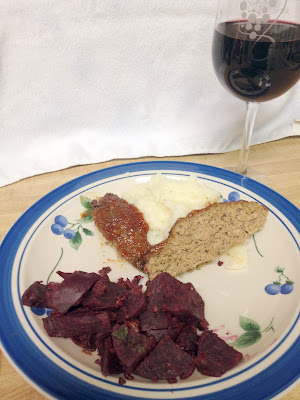- Pork Pot Roast
- Brioche
- Boiled Red Potatoes
- Green Beans
- 2011 Forest Ville Gewürztraminer
- Cinnamon Candied Almonds
My ninth grade Earth Science teacher, Mrs. Strong, had some good advice about expectations. She told us that it is better to expect the worst, while waiting for a graded exam to be returned, than to expect that you aced it. It is better to be pleasantly surprised at exceeding your expectations than to be disappointed. I failed to follow her advice when preparing pork pot roast and I was disappointed in the result.
Pot roast is one of my favorites, tender pieces of beef that fall apart, swimming in a rich, savory gravy. I am also fond of pork so when I saw a recipe for pork pot roast, I was expecting something similar to beef pot roast: very tender meat and a rich, flavorful sauce. Beef pot roast is generally made using chuck, a tough, fatty cut with much connective tissue that contributes to the flavor and moistness of the meat. However, this pork pot roast was made from the loin, a very lean cut with little fat or connective tissue. It is cooked for a long time in a covered pot with apples, onions, and white wine. Less liquid is used for the pork than for the beef so you seal the dutch oven with an extra layer of foil under the lid to help prevent moisture loss.
 The loin that I got consisted of two pieces of meat tied together. The recipe includes double-butterflying the loin, seasoning it, and then tying it back up in its original shape. This procedure gets added seasoning into the thick roast, more than you would get just seasoning the outside. Rather than double butterflying the meat I butterflied each piece, seasoned all sides, and tied them together for roasting. This made for a thick three-pound roast but it still finished cooking in just 1¾ hours.
The loin that I got consisted of two pieces of meat tied together. The recipe includes double-butterflying the loin, seasoning it, and then tying it back up in its original shape. This procedure gets added seasoning into the thick roast, more than you would get just seasoning the outside. Rather than double butterflying the meat I butterflied each piece, seasoned all sides, and tied them together for roasting. This made for a thick three-pound roast but it still finished cooking in just 1¾ hours.I was disappointed in the final result because it lacked the tenderness that I was expecting. It was neither tough nor dried out but it had more chew to it, and less moisture, than I would have liked. It was very nicely seasoned though and the sauce, though a little thin, was delicious and greatly improved the dish.
On the other hand, the brioche was a pleasant surprise. I had never made this before and was inspired to do so by the bread that we had at Morton's. I don't know how they make their bread as they neither name it on their menu nor release the recipe. But the yellow color and tender, slightly sweet crumb inspired me to try brioche. Cook's Illustrated has a recipe for "Quick Brioche", so called because the dough only rises once before baking. The bread is not too difficult to make with a food processor doing much of the work. It is soft and rich with a tender crust, in contrast to the chewy, rustic no-knead breads with crisp crusts that I often make. The flavor comes from the addition of fat to the dough in the form of milk, butter, and eggs. It is good to have a new bread to add to my repertoire when considering future meals.
For the holidays I also made a snack, cinnamon candied almonds, using a simple recipe provided by Dr. Dan in his blog. I used a combination of granulated sugar, super fine sugar, and brown sugar, because I didn't have enough granulated sugar. The raw nuts are coated then cooked for an hour in a low oven. They are turned every 15 minutes and I found it useful to rinse the turner with water each time as it gets coated with a sticky mess of sugars and cinnamon. I used an un-rimmed baking sheet as that is all I had that was large enough. I had to use care when turning the nuts to keep them on the sheet. The parchment paper tended to move around and a rimmed baking sheet would have helped to constrain it. I put a small bowl of these out and they quickly disappeared. We've had to be careful about putting more of these on the table as they are quite irresistible. Diane plans to make some more this holiday season, perhaps using walnuts.
I don't know if there was a problem with the pork or my technique or if it was a problem with my expectations. In any case I don't expect to make this recipe again. I hope that my disappointment is not leading me to miss out on a dish that could be truly enjoyable. Fortunately there are many more recipes to try, both new ones and old favorites, so I'm not too unhappy that this one didn't work out as well as I had hoped. On the other hand, the brioche was a great success and I'm sure to be making it again.
Recipes
Pork Pot Roast from Cook's Illustrated, published as "French-style Pot-roasted Pork Loin"
Brioche from Cook's Illustrated, published as "Quick Brioche"
Cinnamon Candied Almonds from 101 Cooking for Two









































.JPG)
.JPG)



.JPG)




